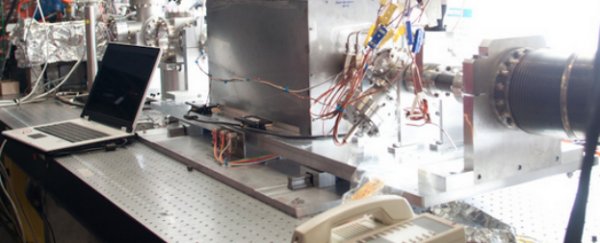Scientists in the US have built a particle collider inside a 30-cm-long box that's capable of accelerating particles more than 500 times faster than current technology.
The device's power comes from the fact that it's filled with plasma - a state of matter in which particles are ionised. And the team from the SLAC National Accelerator Laboratory in California, US, have already used it to accelerate electrons to close to the speed of light - an incredible feat in such a small space.
The collider relies on a type of acceleration that was first proposed in the '70s known as plasma wakefield acceleration, but this is the first device to show that it actually works, and is far more efficient than current acceleration technology.
To put it into comparison, CERN's Large Hadron Collider in Switzerland does what this tiny devices does, but it's around 27 km long, and China's just proposed a supercollider that will be almost 80 km in length.
The collider is too small to be very useful to science right now, but the research shows that the technology could be scaled up to create a new generation of super-powerful colliders.
"To put these results in context, we have now shown that we could use this technique to accelerate an electron beam to the same energies achieved in the 2-mile-long [3.2 km] SLAC linear accelerator in less than 20 feet [6 metres]."
It's an important step, because in order to better understand the physics that governs the Universe, we need devices that are more powerful than the ones we have now.
"In order to go to the next level, to push the energy boundaries even higher, one can imagine trying to build larger machines, but you reach a limit at some point," Michael Litos, the physicist who led the project, explained in the video below. "In order to go to those higher energies we have to think of a paradigm shift in the way we acclerate our particles so we can accelerate them to higher energies in much less space."
This paradigm shift comes in the form of plasma wakefield acceleration, Litos told Jason Koebler from Motherboard. "All of a sudden, a 50 kilometre accelerator becomes something like 5 kilometres," he said.
Traditional particle colliders currrently speed up beams of electrons by placing them in a vacuum and using electromagnetic field to accelerate them.
This works well, but a lot of energy is required to do this, which is why the devices are so large.
Instead, Litos and his team filled their tube with plasma, created by heating and then ionising lithium gas with a laser, before they shot out two bunches of electrons one after the other. Each bunch contained around 5 to 6 billion electrons.
The electrons in the front (the driving bunch) pass energy back to the bunch behind them (the trailing bunch), and each time this happens it causes the trailing electrons to get faster and faster. This effectively creates large waves of plasma that the elctrons surf on. The team's results are published in Nature.
"We send them in right after another. The first gives up its energy to the second bunch, and we can accelerate these much faster in a shorter distance," Litos told Koebler over at Motherboard. "If you repeat this many, many times, you can scale this up to make an application-driven collider."
The team is now working on ways to make it easier to create the plasma, which is a crucial step before scaling up the technology.
If they accomplish this they can use the technology to build a collider that could perform tasks like the Large Hadron Collider, such as looking for mysterious particles like the Higgs boson and trying to replicate what happened at the birth of the Universe.
But for now they've overcome one of the biggest hurdles in creating small and affordable accelerators, which will hopefully open up doors for a lot more groundbreaking research to be done around the world. We can't wait.
Find out more about the breakthrough below:

And watch this animation for more information on how plasma wakefield acceleration works:

